How Millennials compare with prior generations – Pew Research Center
Learn our analysis on: Immigration & Migration | Podcasts | Election 2024
Learn our analysis on: Immigration & Migration | Podcasts | Election 2024
Over the previous 50 years – from the Silent Technology’s younger maturity to that of Millennials at this time – the USA has undergone giant cultural and societal shifts. Now that the youngest Millennials are adults, how do they examine with those that had been their age within the generations that got here earlier than them?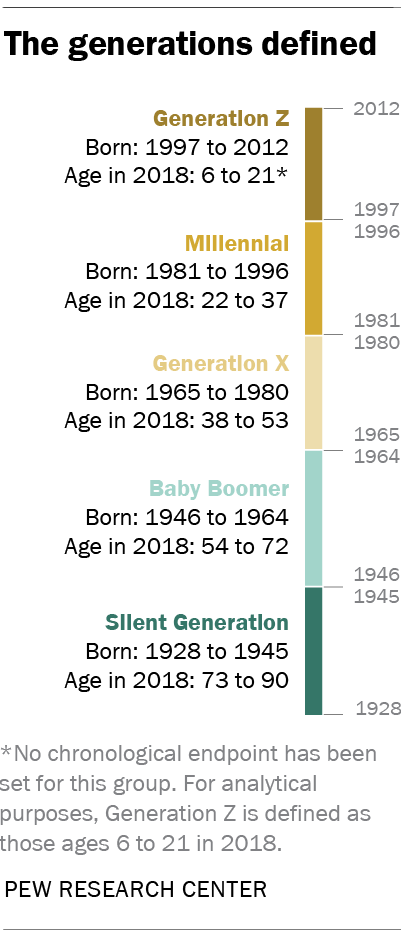 Typically, they’re higher educated – an element tied to employment and monetary well-being – however there’s a sharp divide between the financial fortunes of those that have a university training and people who don’t.
Typically, they’re higher educated – an element tied to employment and monetary well-being – however there’s a sharp divide between the financial fortunes of those that have a university training and people who don’t.
Millennials have introduced extra racial and ethnic variety to American society. And Millennial ladies, like Technology X ladies, usually tend to take part within the nation’s workforce than prior generations.
In contrast with earlier generations, Millennials – these ages 22 to 37 in 2018 – are delaying or foregoing marriage and have been considerably slower in forming their very own households. They’re additionally extra prone to be residing at residence with their dad and mom, and for longer stretches.
And Millennials are actually the second-largest technology within the U.S. citizens (after Child Boomers), a proven fact that continues to form the nation’s politics given their Democratic leanings compared with older generations.
These are a few of the broad strokes which have emerged from Pew Analysis Heart’s work on Millennials over the previous few years. Now that the youngest Millennials are of their 20s, we’ve got completed a complete replace of our prior demographic work on generations. Listed below are the small print.
At the moment’s younger adults are significantly better educated than their grandparents, because the share of younger adults with a bachelor’s diploma or greater has steadily climbed since 1968. Amongst Millennials, round four-in-ten (39%) of these ages 25 to 37 have a bachelor’s diploma or greater, in contrast with simply 15% of the Silent Technology, roughly 1 / 4 of Child Boomers and about three-in-ten Gen Xers (29%) after they had been the identical age.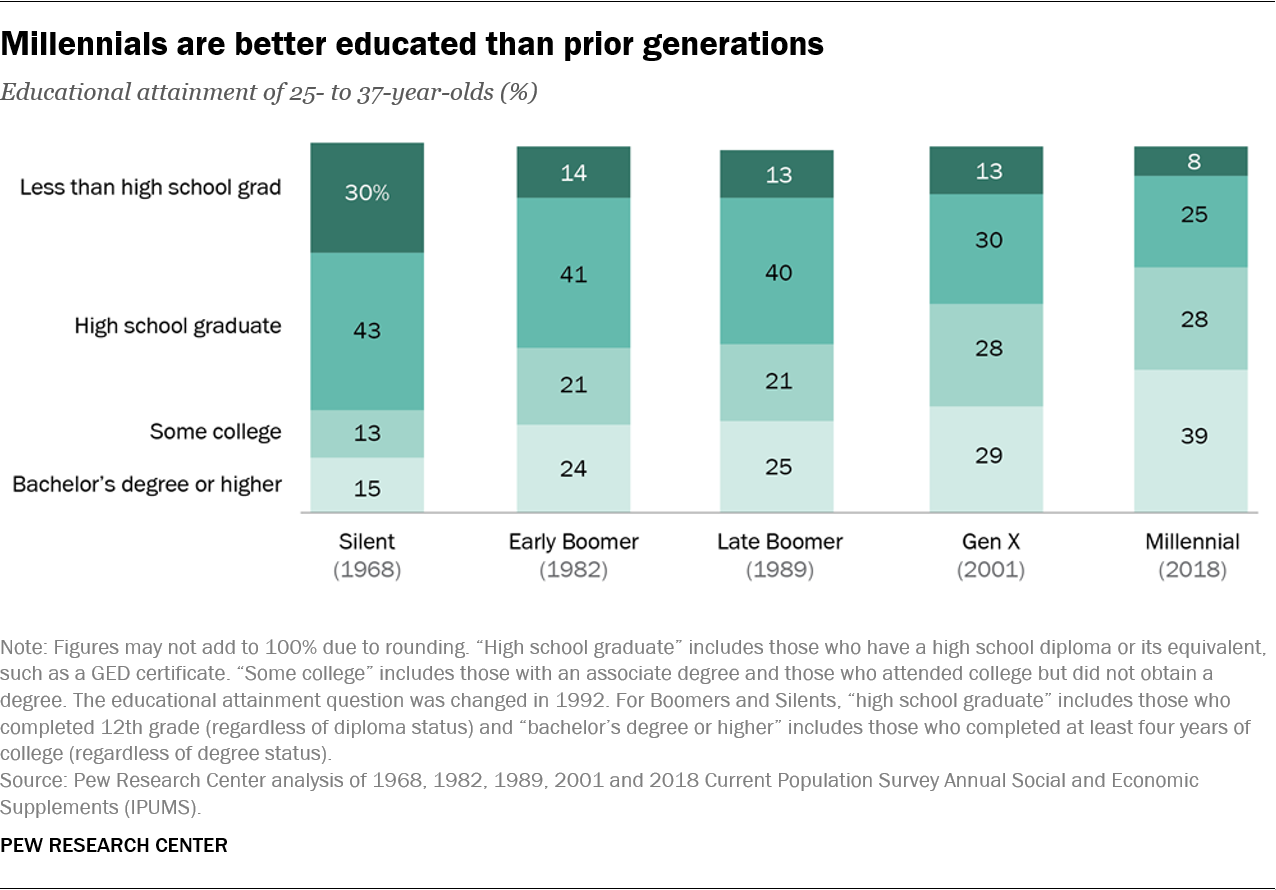
Features in instructional attainment have been particularly steep for younger ladies. Amongst ladies of the Silent Technology, solely 11% had obtained a minimum of a bachelor’s diploma after they had been younger (ages 25 to 37 in 1968). Millennial ladies are about 4 occasions (43%) as probably as their Silent predecessors to have accomplished as a lot training on the identical age. Millennial males are additionally higher educated than their predecessors. About one-third of Millennial males (36%) have a minimum of a bachelor’s diploma, almost double the share of Silent Technology males (19%) after they had been ages 25 to 37.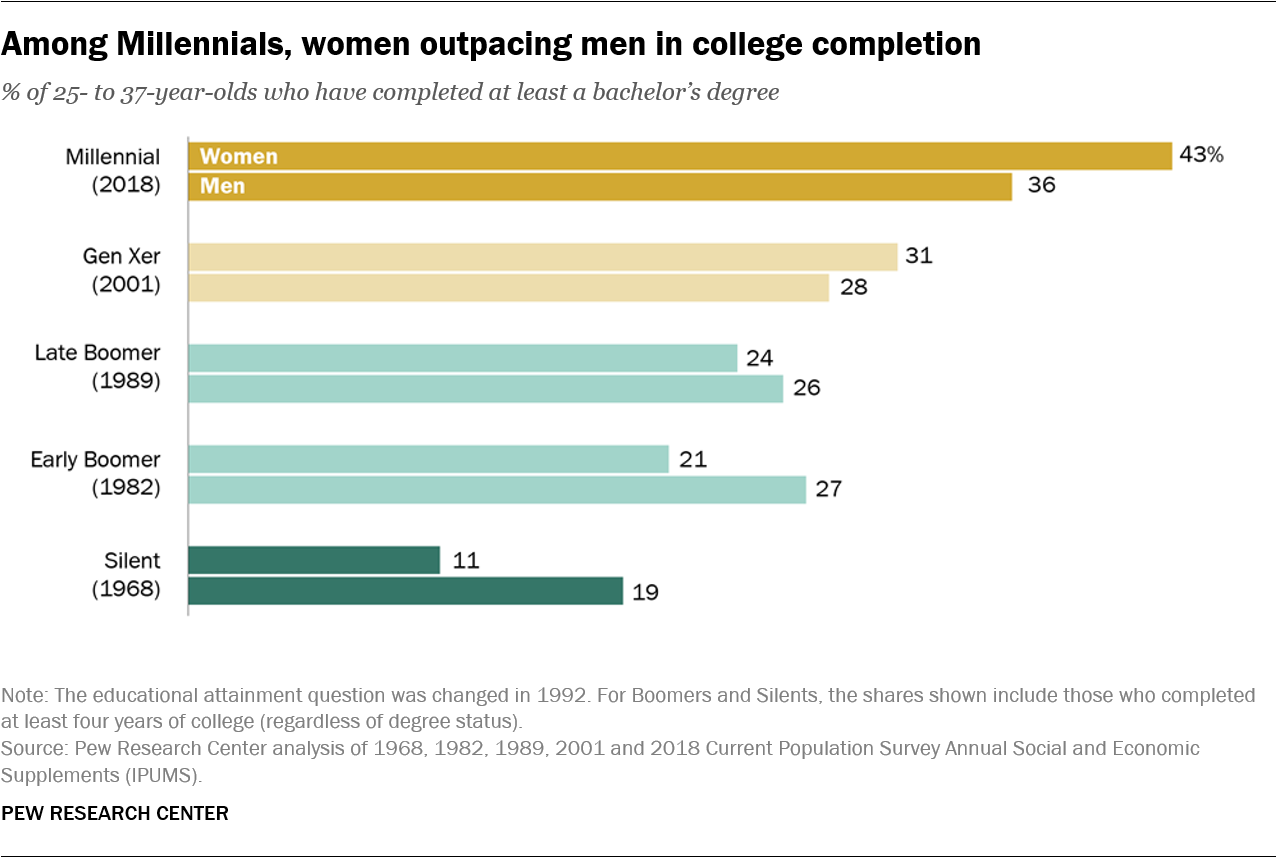
Whereas instructional attainment has steadily elevated for women and men over the previous 5 many years, the share of Millennial ladies with a bachelor’s diploma is now greater than that of males – a reversal from the Silent Technology and Boomers. Gen X ladies had been the primary to outpace males by way of training, with a 3-percentage-point benefit over Gen X males in 2001. Earlier than that, late Boomer males in 1989 had a 2-point benefit over Boomer ladies.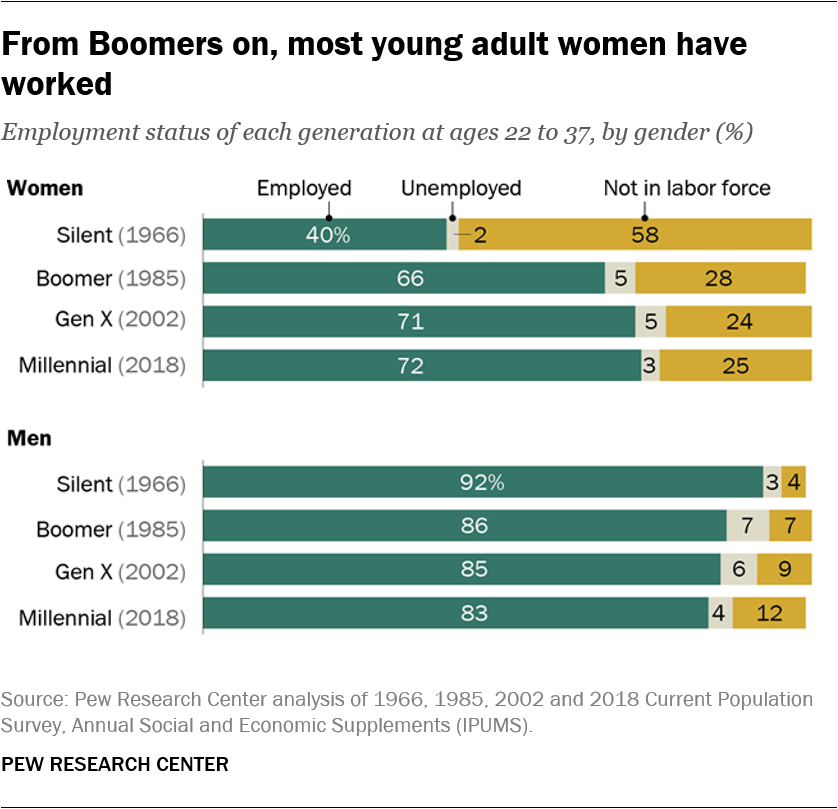 Boomer ladies surged into the workforce as younger adults, setting the stage for extra Gen X and Millennial ladies to comply with swimsuit. In 1966, when Silent Technology ladies had been ages 22 by means of 37, a majority (58%) had been not taking part within the labor power whereas 40% had been employed. For Millennial ladies at this time, 72% are employed whereas only a quarter aren’t within the labor power. Boomer ladies had been the turning level. As early as 1985, extra younger Boomer ladies had been employed (66%) than weren’t within the labor power (28%).
Boomer ladies surged into the workforce as younger adults, setting the stage for extra Gen X and Millennial ladies to comply with swimsuit. In 1966, when Silent Technology ladies had been ages 22 by means of 37, a majority (58%) had been not taking part within the labor power whereas 40% had been employed. For Millennial ladies at this time, 72% are employed whereas only a quarter aren’t within the labor power. Boomer ladies had been the turning level. As early as 1985, extra younger Boomer ladies had been employed (66%) than weren’t within the labor power (28%).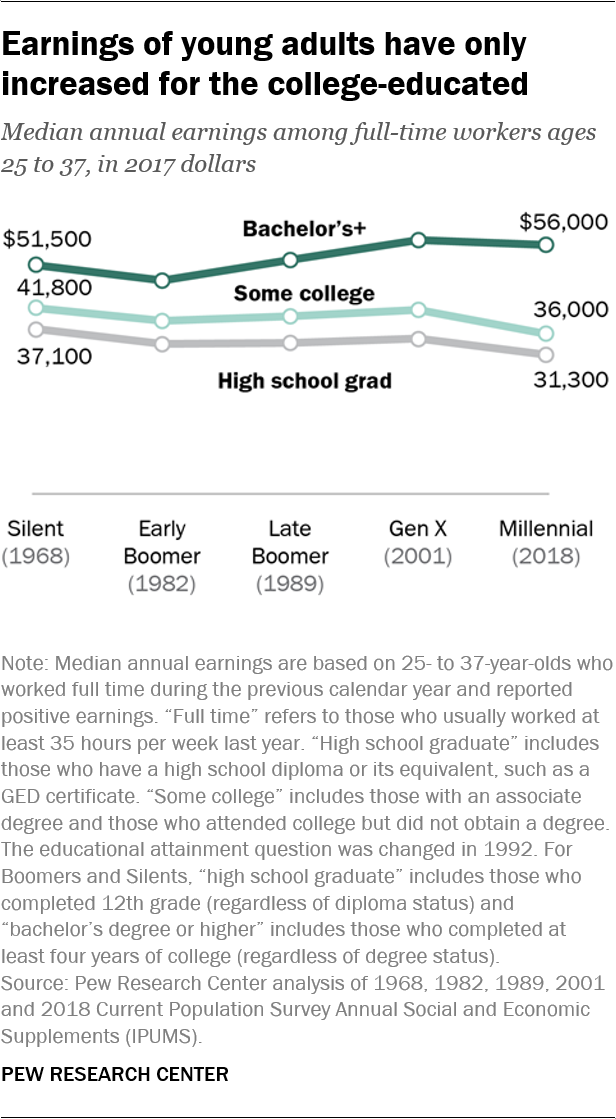
And regardless of a repute for job hopping, Millennial staff are simply as prone to stick with their employers as Gen X staff had been after they had been the identical age. Roughly seven-in-ten every of Millennials ages 22 to 37 in 2018 (70%) and Gen Xers the identical age in 2002 (69%) reported working for his or her present employer a minimum of 13 months. About three-in-ten of each teams mentioned they’d been with their employer for a minimum of 5 years.
After all, the financial system diversified for every technology. Whereas the Nice Recession affected People broadly, it created a particularly challenging job market for Millennials getting into the workforce. The unemployment price was particularly excessive for America’s youngest adults within the years simply after the recession, a actuality that will influence Millennials’ future earnings and wealth.
The monetary well-being of Millennials is sophisticated. The person earnings for younger staff have remained largely flat over the previous 50 years. However this belies a notably large gap in earnings between Millennials who’ve a university training and people who don’t. Equally, the family earnings traits for younger adults markedly diverge by training. So far as family wealth, Millennials seem to have gathered barely lower than older generations had on the identical age.
Millennials with a bachelor’s diploma or extra and a full-time job had median annual earnings valued at $56,000 in 2018, roughly equal to these of college-educated Technology X staff in 2001. However for Millennials with some school or much less, annual earnings had been decrease than their counterparts in prior generations. For instance, Millennial staff with some school training reported making $36,000, decrease than the $38,900 early Child Boomer staff made on the identical age in 1982. The sample is comparable for these younger adults who by no means attended school.
Millennials in 2018 had a median family earnings of roughly $71,400, just like that of Gen X younger adults ($70,700) in 2001. (This evaluation is in 2017 {dollars} and is adjusted for family dimension. Moreover, family earnings consists of the earnings of the younger grownup, in addition to the earnings of anybody else residing within the family.)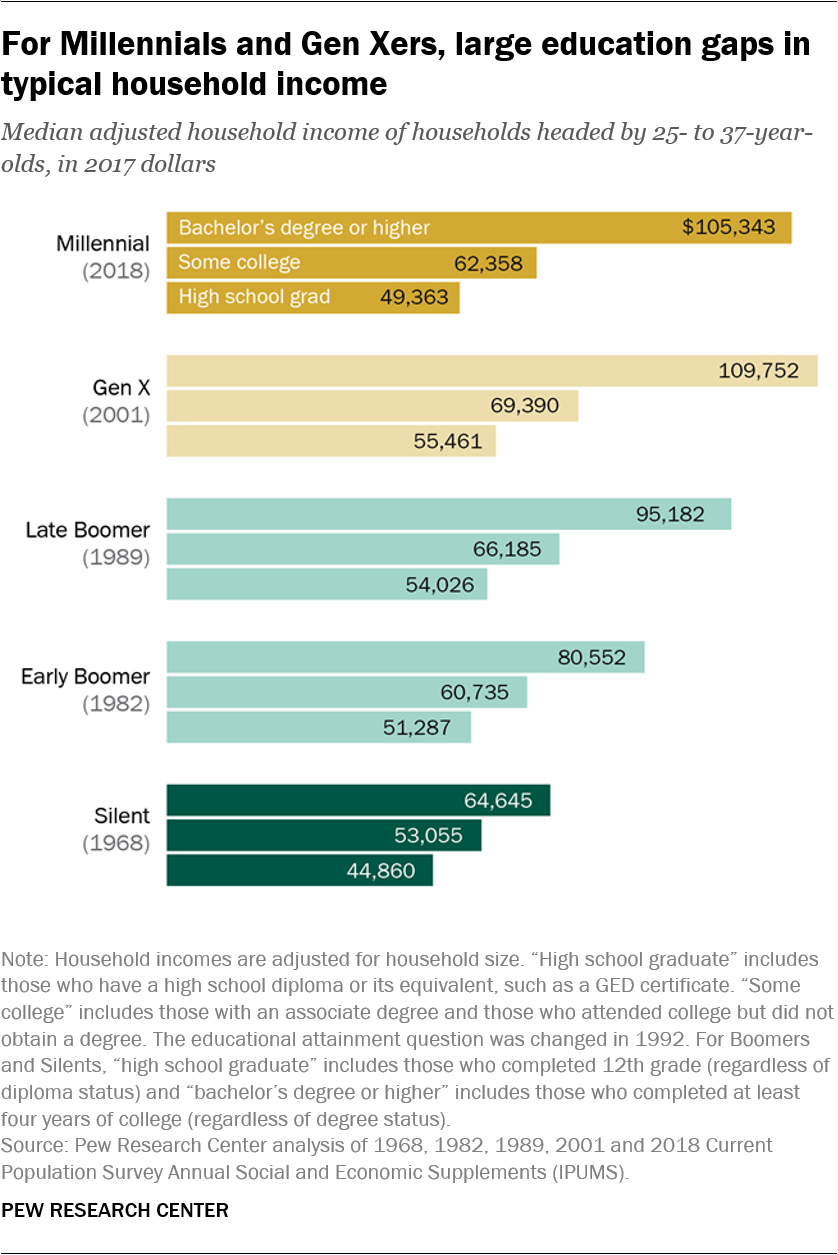 The rising hole by training is much more obvious when annual family earnings. For households headed by Millennials ages 25 to 37 in 2018, the median adjusted family earnings was about $105,300 for these with a bachelor’s diploma or greater, roughly $56,000 higher than that of households headed by highschool graduates. The median family earnings distinction by training for prior generations ranged from $41,200 for late Boomers to $19,700 for the Silent Technology after they had been younger.
The rising hole by training is much more obvious when annual family earnings. For households headed by Millennials ages 25 to 37 in 2018, the median adjusted family earnings was about $105,300 for these with a bachelor’s diploma or greater, roughly $56,000 higher than that of households headed by highschool graduates. The median family earnings distinction by training for prior generations ranged from $41,200 for late Boomers to $19,700 for the Silent Technology after they had been younger.
Whereas younger adults normally should not have a lot gathered wealth, Millennials have barely much less wealth than Boomers did on the identical age. The median internet value of households headed by Millennials (ages 20 to 35 in 2016) was about $12,500 in 2016, in contrast with $20,700 for households headed by Boomers the identical age in 1983. Median internet value of Gen X households on the identical age was about $15,100.
This modest distinction in wealth could be partly attributed to variations in debt by technology. In contrast with earlier generations, extra Millennials have excellent scholar debt, and the quantity of it they owe tends to be higher. The share of younger grownup households with any scholar debt doubled from 1998 (when Gen Xers had been ages 20 to 35) to 2016 (when Millennials had been that age). As well as, the median quantity of debt was almost 50% higher for Millennials with excellent scholar debt ($19,000) than for Gen X debt holders after they had been younger ($12,800).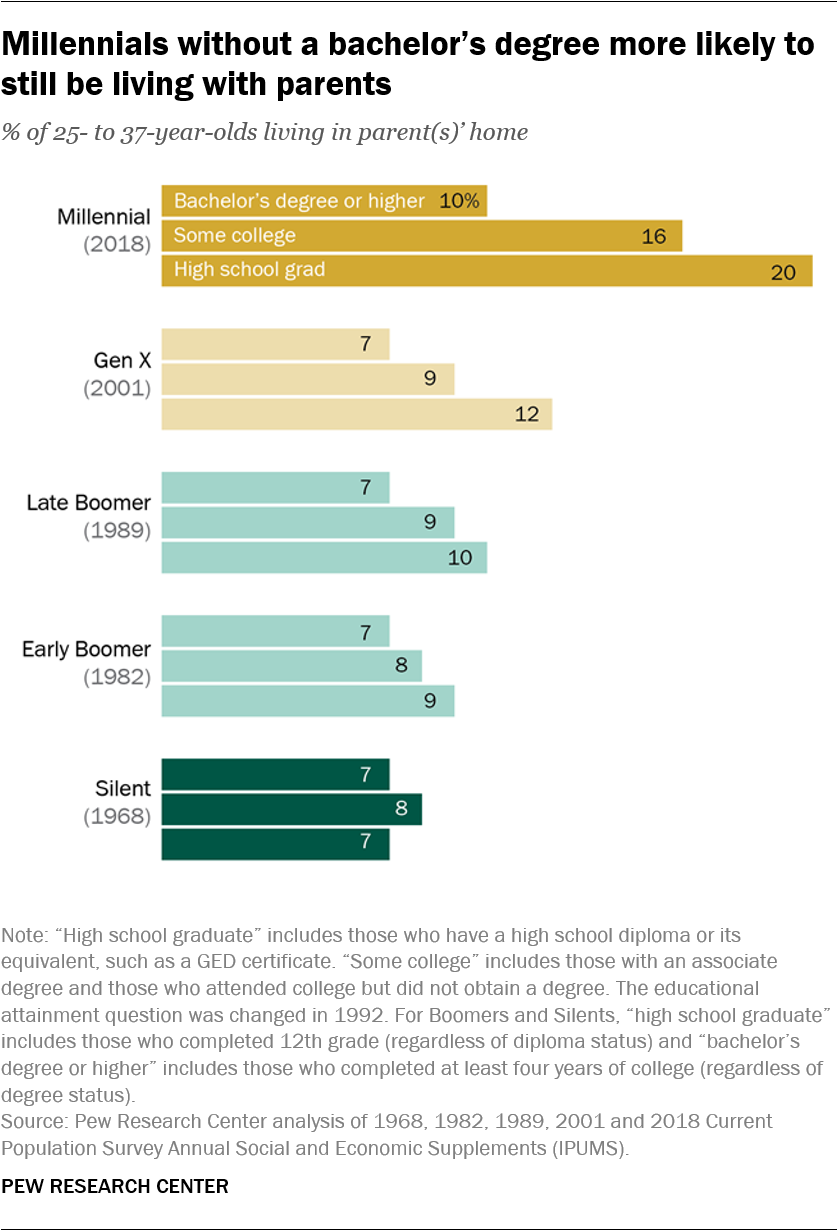 Millennials, hit laborious by the Nice Recession, have been considerably slower in forming their own households than earlier generations. They’re extra prone to dwell of their dad and mom’ residence and likewise extra prone to be at home for longer stretches. In 2018, 15% of Millennials (ages 25 to 37) had been residing of their dad and mom’ residence. That is almost double the share of early Boomers and Silents (8% every) and 6 proportion factors greater than Gen Xers who did so after they had been the identical age.
Millennials, hit laborious by the Nice Recession, have been considerably slower in forming their own households than earlier generations. They’re extra prone to dwell of their dad and mom’ residence and likewise extra prone to be at home for longer stretches. In 2018, 15% of Millennials (ages 25 to 37) had been residing of their dad and mom’ residence. That is almost double the share of early Boomers and Silents (8% every) and 6 proportion factors greater than Gen Xers who did so after they had been the identical age.
The rise in younger adults residing at house is especially prominent amongst these with decrease training. Millennials who by no means attended school had been twice as probably as these with a bachelor’s diploma or extra to dwell with their dad and mom (20% vs. 10%). This hole was narrower or nonexistent in earlier generations. Roughly equal shares of Silents (about 7% every) lived of their dad and mom’ residence after they had been ages 25 to 37, no matter instructional attainment.
Millennials are additionally moving significantly less than earlier generations of younger adults. About one-in-six Millennials ages 25 to 37 (16%) have moved up to now yr. For earlier generations on the identical age, roughly 1 / 4 had.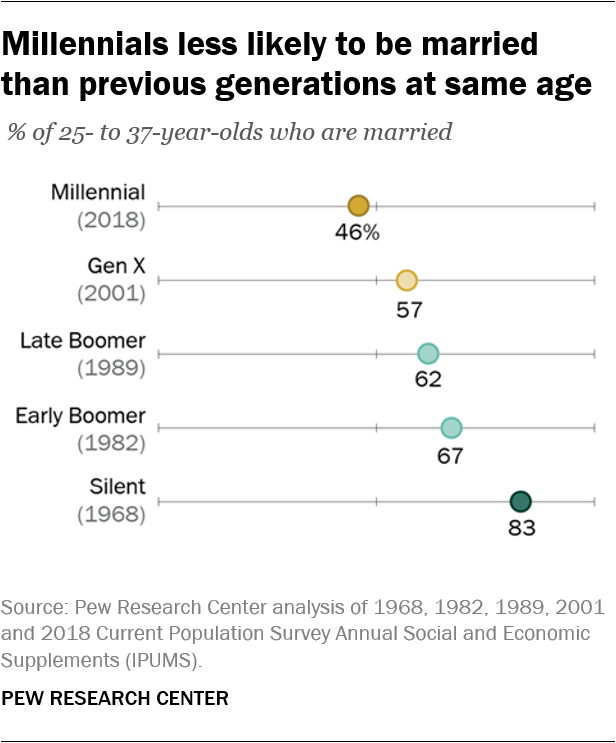 On the entire, Millennials are beginning households later than their counterparts in prior generations. Slightly below half (46%) of Millennials ages 25 to 37 are married, a steep drop from the 83% of Silents who had been married in 1968. The share of 25- to 37-year-olds who had been married steadily dropped for every succeeding technology, from 67% of early Boomers to 57% of Gen Xers. This partly displays broader societal shifts towards marrying later in life. In 1968, the standard American girl first married at age 21 and the standard American man first wed at 23. At the moment, these figures have climbed to twenty-eight for girls and 30 for males.
On the entire, Millennials are beginning households later than their counterparts in prior generations. Slightly below half (46%) of Millennials ages 25 to 37 are married, a steep drop from the 83% of Silents who had been married in 1968. The share of 25- to 37-year-olds who had been married steadily dropped for every succeeding technology, from 67% of early Boomers to 57% of Gen Xers. This partly displays broader societal shifts towards marrying later in life. In 1968, the standard American girl first married at age 21 and the standard American man first wed at 23. At the moment, these figures have climbed to twenty-eight for girls and 30 for males.
However it’s not all about delayed marriage. The share of adults who’ve by no means married is growing with every successive technology. If present patterns proceed, an estimated one-in-four of at this time’s younger adults will have never married by the point they attain their mid-40s to early 50s – a file excessive share.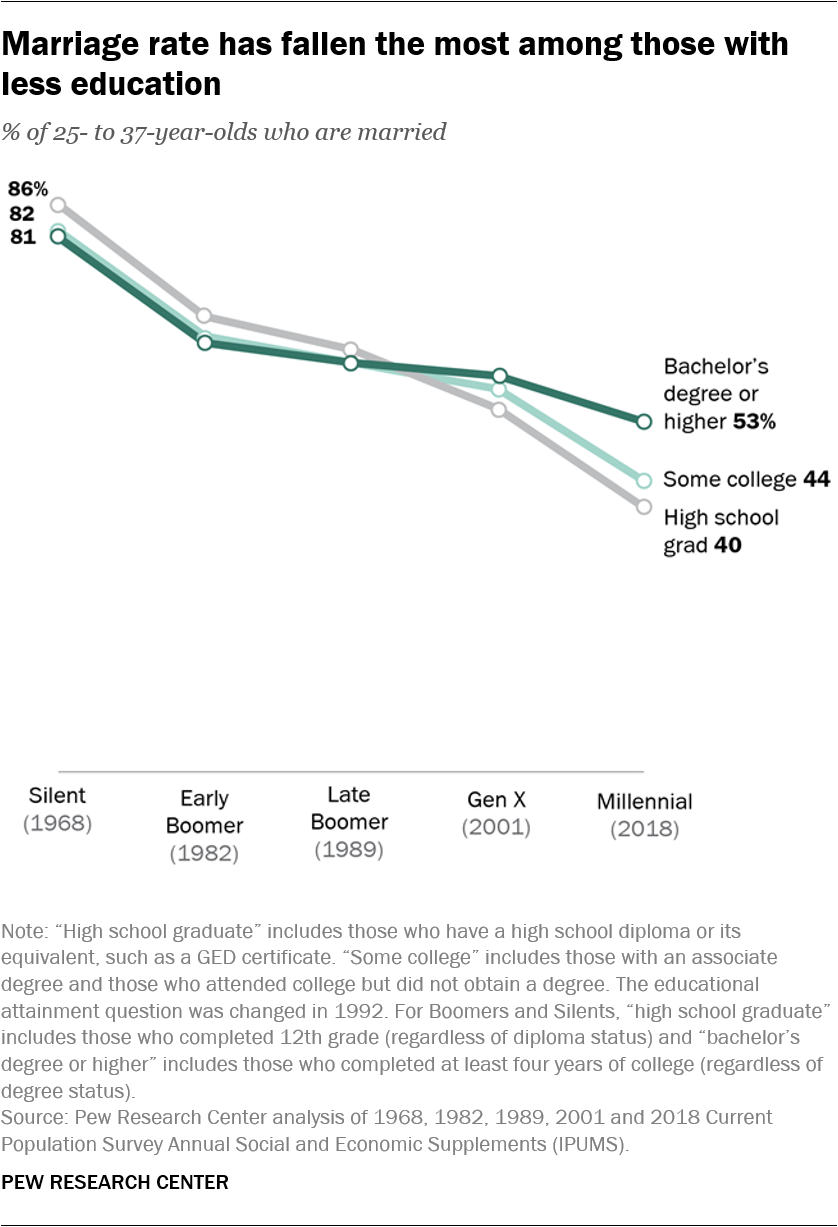 In prior generations, these ages 25 to 37 whose highest degree of training was a highschool diploma had been extra probably than these with a bachelor’s diploma or greater to be married. Gen Xers reversed this development, and the divide widened amongst Millennials. 4-in-ten Millennials with only a highschool diploma (40%) are at the moment married, in contrast with 53% of Millennials with a minimum of a bachelor’s diploma. Compared, 86% of Silent Technology highschool graduates had been married in 1968 versus 81% of Silents with a bachelor’s diploma or extra.
In prior generations, these ages 25 to 37 whose highest degree of training was a highschool diploma had been extra probably than these with a bachelor’s diploma or greater to be married. Gen Xers reversed this development, and the divide widened amongst Millennials. 4-in-ten Millennials with only a highschool diploma (40%) are at the moment married, in contrast with 53% of Millennials with a minimum of a bachelor’s diploma. Compared, 86% of Silent Technology highschool graduates had been married in 1968 versus 81% of Silents with a bachelor’s diploma or extra.
Millennial ladies are additionally waiting longer to become parents than prior generations did. In 2016, 48% of Millennial ladies (ages 20 to 35 on the time) had been mothers. When Technology X ladies had been the identical age in 2000, 57% had been already moms, just like the share of Boomer ladies (58%) in 1984. Nonetheless, Millennial ladies now account for the overwhelming majority of annual U.S. births, and greater than 17 million Millennial ladies have change into moms.
Youthful generations (Technology X, Millennials and Technology Z) now make up a transparent majority of America’s voting-eligible population. As of November 2018, almost six-in-ten adults eligible to vote (59%) had been from one among these three generations, with Boomers and older generations making up the opposite 41%.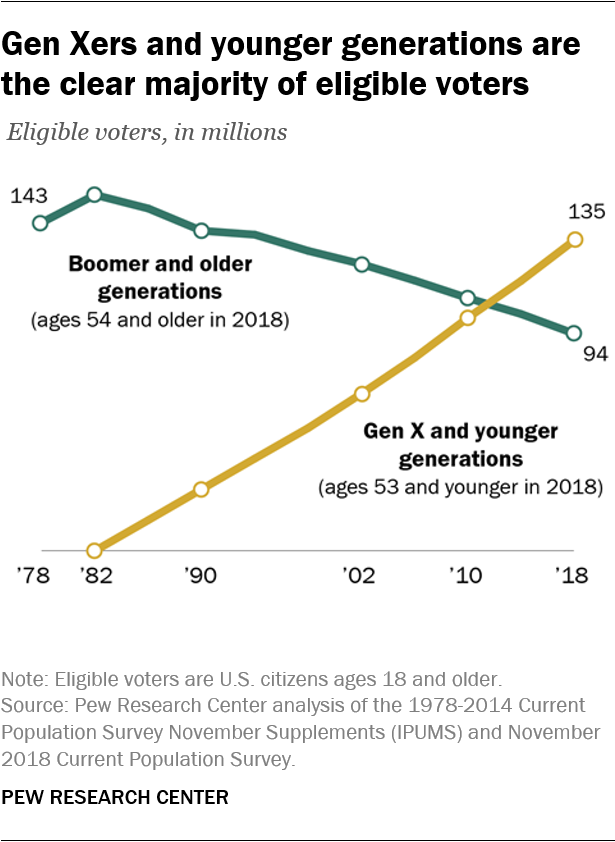 Nevertheless, younger adults have traditionally been less likely to vote than their older counterparts, and these youthful generations have adopted that very same sample, turning out to vote at decrease charges than older generations in latest elections.
Nevertheless, younger adults have traditionally been less likely to vote than their older counterparts, and these youthful generations have adopted that very same sample, turning out to vote at decrease charges than older generations in latest elections.
Within the 2016 election, Millennials and Gen Xers cast more votes than Boomers and older generations, giving the youthful generations a slight majority of complete votes solid. Nevertheless, greater shares of Silent/Best technology eligible voters (70%) and Boomers (69%) reported voting within the 2016 election in contrast with Gen X (63%) and Millennial (51%) eligible voters. Going ahead, Millennial turnout could improve as this technology grows older.
Generational variations in political attitudes and partisan affiliation are as broad as they’ve been in many years. Amongst registered voters, 59% of Millennials affiliate with the Democratic Celebration or lean Democratic, in contrast with about half of Boomers and Gen Xers (48% every) and 43% of the Silent Technology. With this divide comes generational differences on specific issue areas, from views of racial discrimination and immigration to international coverage and the scope of presidency.
By 2019, Millennials are projected to quantity 73 million, overtaking Child Boomers as the largest living adult generation. Though a higher variety of births underlie the Child Growth technology, Millennials will outnumber Boomers partly as a result of immigration has been boosting their numbers.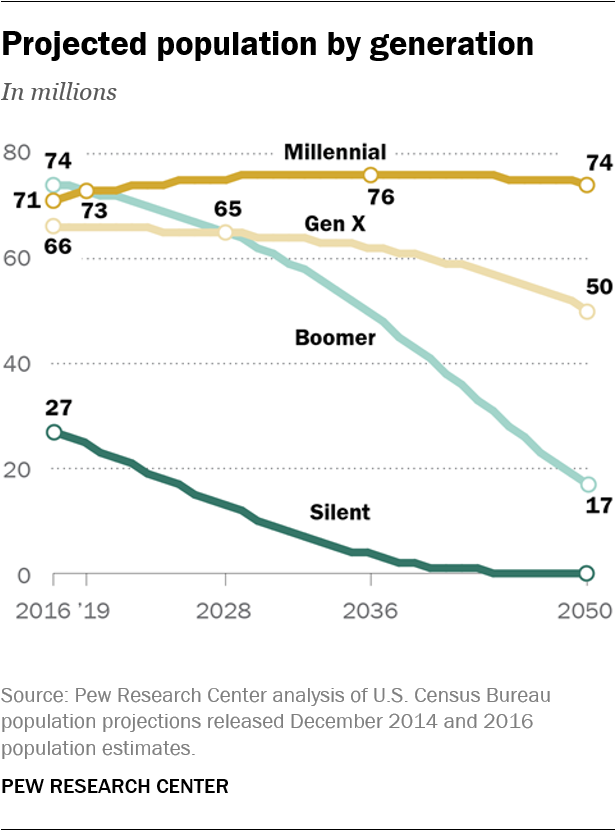 Millennials are additionally bringing extra racial and ethnic variety. When the Silent Technology was younger (ages 22 to 37), 84% had been non-Hispanic white. For Millennials, the share is simply 55%. This transformation is pushed partly by the growing number of Hispanic and Asian immigrants, whose ranks have elevated for the reason that Boomer technology. The increased prevalence of interracial marriage and differences in fertility patterns have additionally contributed to the nation’s shifting racial and ethnic make-up.
Millennials are additionally bringing extra racial and ethnic variety. When the Silent Technology was younger (ages 22 to 37), 84% had been non-Hispanic white. For Millennials, the share is simply 55%. This transformation is pushed partly by the growing number of Hispanic and Asian immigrants, whose ranks have elevated for the reason that Boomer technology. The increased prevalence of interracial marriage and differences in fertility patterns have additionally contributed to the nation’s shifting racial and ethnic make-up.
Wanting forward on the subsequent technology, early benchmarks present Generation Z (these ages 6 to 21 in 2018) is on monitor to be the nation’s most diverse and best-educated generation but. Practically half (48%) are racial or ethnic minorities. And whereas most are nonetheless in Ok-12 faculties, the oldest Gen Zers are enrolling in school at a better price than even Millennials had been at their age. Early indications are that their opinions on points are similar to those of Millennials.
After all, Gen Z remains to be very younger and could also be formed by future unknown occasions. However Pew Analysis Heart seems ahead to spending the following few years finding out life for this new technology because it enters maturity.
All images through Getty Pictures
Signal as much as to obtain a month-to-month digest of the Heart’s newest analysis on the attitudes and behaviors of People in key realms of every day life
1615 L St. NW, Suite 800
Washington, DC 20036
USA
(+1) 202-419-4300 | Main
(+1) 202-857-8562 | Fax
(+1) 202-419-4372 | Media Inquiries
About Pew Research Center Pew Analysis Heart is a nonpartisan reality tank that informs the general public concerning the points, attitudes and traits shaping the world. It conducts public opinion polling, demographic analysis, media content material evaluation and different empirical social science analysis. Pew Analysis Heart doesn’t take coverage positions. It’s a subsidiary of The Pew Charitable Trusts.







